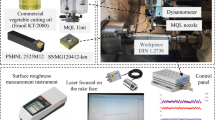Abstract
Heat generated in the cutting zone during metal cutting has an undeniable controlling influence on the dimensional accuracy of the workpiece and tool life. The heat dissipation process in the cutting zone is critical to the type of metalworking fluid (MWF) used and the way it is delivered to the cutting zone. Although extended studies have analyzed the thermal aspect of the machining process, few, if any, have incorporated the influence of the delivery method (application) of the MWF on the convective heat transfer process. In this paper, a comprehensive approach analysis was taken to assess the heat generation in the cutting process. Analytical models were developed to estimate the amount of heat generated in the shear zone and the heat partition in the shear plane during the milling process. In addition, the heat transfer coefficients of metalworking fluids during flooding, minimum quantity lubrication (MQL), and through-spindle cooling (TSC) strategies were evaluated. Regarding MQL, the determination of heat transfer coefficients of metalworking fluids involves the use of a homogeneous single-phase flow assumption of the two fluids (air and lubricant). Next, the average temperature change in the workpiece was estimated by considering the conductive and convective heat transfer coefficients of the workpiece and fluids. Finally, the analytical models of the temperature change in the workpiece were experimentally validated against workpiece-embedded thermocouple measurements. It was found that the results of the models show good agreement with the experimental results.
Similar content being viewed by others
References
Childs T (2000) Metal machining: theory and applications. Butterworth-Heinemann, London
Astakhov V, Joksch S (2012) Metalworking fluids (MWFs) for cutting and grinding. Woodhead, Cambridge
Ghani M, Abukhshim N, Sheikh M (2008) An investigation of heat partition and tool wear in hard turning of H13 tool steel with CBN cutting tools. Int J Adv Manuf Technol 39(9–10):874–888
Sanchez LE, Mello HJ, Neto RRI, Davim JP (2014) Hot turning of a difficult-to-machine steel (sae xev-f) aided by infrared radiation. Int J Adv Manuf Technol 73(5–8):887–898
Dahlman P, Escursell M (2004) High-pressure jet-assisted cooling: a new possibility for near net shape turning of decarburized steel. Int J Mach Tools Manuf 44(1):109–115
Yildiz Y, Nalbant M (2008) A review of cryogenic cooling in machining processes. Int J Mach Tools Manuf 48(9):947–964
Wang C, Li K, Chen M, Liu Z (2015) Evaluation of minimum quantity lubrication effects by cutting force signals in face milling of Inconel 182 overlays. J Clean Prod 108:145–157
Sharif MN, Pervaiz S, Deiab I (2016) Potential of alternative lubrication strategies for metal cutting processes: a review. Int J Adv Manuf Technol 89(5):2447–2479
Byers J (2016) Metalworking fluids. CRC, New York
Sreejith P, Ngoi B (2000) Dry machining: machining of the future. J Mater Process Technol 101(1–3):287–291
Shaw M (2005) Metal cutting principles. Oxford University Press, New York
Sandvik A (1994) Modern metal cutting—a practical handbook. Tofters Tryckeri AB, Idereklam, Sandviken
Parashar B, Mittal R (2002) Elements of manufacturing processes. PHI Learning Pvt. Ltd., New Delhi
Arshinov V, Alekseev G (1979) Metal cutting theory and cutting tool design. Mir Publishers, Moscow
Brinksmeier E, Meyer D, Huesmann-Cordes AG, Herrmann C (2015) Metalworking fluids—mechanisms and performance. CIRP Annals-Manufacturing Technology 64(2):605–628
Daniel C, Olson W and Sutherland J (1997) Research advances in dry and semi-dry machining, SAE Technical Paper, No. 970415
Wertheim R, Rotberg J, Ber A (1992) Influence of high-pressure flushing through the rake face of the cutting tool. CIRP Ann Manuf Technol 41(1):101–106
Diniz A, Micaroni R (2007) Influence of the direction and flow rate of the cutting fluid on tool life in turning process of AISI 1045 steel. Int J Mach Tools Manuf 47(2):247–254
Rahman M, Senthil Kumar A, Salam M (2002) Experimental evaluation on the effect of minimal quantities of lubricant in milling. Int J Mach Tools Manuf 42(5):539–547
Graham D (2000) Dry out [dry machining]. Cutting Tool Eng’g
Feng Y, Zheng L, Wang M, Wang B, Hou J, Yuan T (2015) Research on cutting temperature of work-piece in milling process based on WPSO. Int J Adv Manuf Technol 79(1):427–435
Jaspers SP, Dautzenberg JH, Taminiau DA (1998) Temperature measurement in orthogonal metal cutting. Int J Adv Manuf Technol 14(1):7–12
Hahn RS (1951). On the temperature developed at the shear plane in the metalcutting process. Journal of Applied Mechanics-Transactions of the ASME vol. 18, no. 3, pp. 323–323
Blok H (1937) Theoretical study of temperature rise at surfaces of actual contact under oiliness lubricating conditions, Proceedings of the general discussion on lubrication and lubricants, 2
Jaeger JC (1942) Moving sources of heat and the temperature at sliding contacts. Proc Roy Soc, NSW 76:203–224
Dogu Y, Aslan E, Camuscu N (2006) A numerical model to determine temperature distribution in orthogonal metal cutting. J Mater Process Technol 171(1):1–9
Rohsenow W, Hartnett J, Ganić E (1985) Handbook of heat transfer applications. McGraw-Hill, New York
Hadad M, Sadeghi B (2012) Thermal analysis of minimum quantity lubrication-MQL grinding process. Int J Mach Tools Manuf 63:1–15
Levy S (1999) Two-phase flow in complex systems. Wiley, New York
Author information
Authors and Affiliations
Corresponding author
Rights and permissions
About this article
Cite this article
Al Sofyani, S., Marinescu, I.D. Analytical modeling of the thermal aspects of metalworking fluids in the milling process. Int J Adv Manuf Technol 92, 3953–3966 (2017). https://doi.org/10.1007/s00170-017-0429-4
Received:
Accepted:
Published:
Issue Date:
DOI: https://doi.org/10.1007/s00170-017-0429-4




